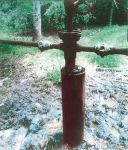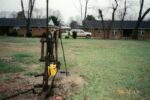- Like
- Digg
- Del
- Tumblr
- VKontakte
- Buffer
- Love This
- Odnoklassniki
- Meneame
- Blogger
- Amazon
- Yahoo Mail
- Gmail
- AOL
- Newsvine
- HackerNews
- Evernote
- MySpace
- Mail.ru
- Viadeo
- Line
- Comments
- Yummly
- SMS
- Viber
- Telegram
- Subscribe
- Skype
- Facebook Messenger
- Kakao
- LiveJournal
- Yammer
- Edgar
- Fintel
- Mix
- Instapaper
- Copy Link
In order for people in your county to be able to get flood insurance, or receive benefits from FEMA in the event of a flood (or maybe other) disaster, the county (or municipality if you happen to be in a town or city) has to have a “floodplain ordinance”. That ordinance contains limits on construction in the floodplain – and particularly in the “floodway” part of the floodplain that the high water needs to flow on downstream. This is supposed to prevent filling the floodplain or obstructing the floodway that would make future floods more severe and damaging. The floodplain ordinance also contains a permit system that is supposed to make sure that the limits are observed. These ordinances have not always been applied to gas drilling etc. operations. But the ordinances do apply to drillers, and enforcement is occurring now. FEMA itself has recently issued technical guidance for floodplain permitting for oil and gas wells.
The driller has to get a permit from the county floodplain administrator before it can begin moving dirt into a “flood hazard” area, which is another word for a floodplain. The decision of the floodplain administrator can be appealed to the County Commission. (Note that this floodplain ordinance/permit is a function of COUNTY government. The STATE Department of Environmental Protection does NOT issue or enforce this permit. The State D.E.P. may informally make sure that the driller has at least applied for the county permit before the State will get to work issuing the state driller permit.)
We think you as the surface owner have a constitutional right to a notice and hearing plus a right to appeal on the application for and issuance of that permit. At least one Circuit Court Judge has issued an opinion that agrees with our position. However, the floodplain ordinances we have seen do not contain those provisions! So it is important for you to be proactive and find out if the proposed drilling activity is in a floodplain, and if so, get down to the County Courthouse and the “floodplain administrator” and let them know of your concerns for the increased flooding/flood risk that the driller’s activity might cause. If you have not been threatened yet, but just want your county to do right, you should go to your county commissioners and urge them to make changes giving surface owner notice. Those changes are being considered as this is written by the Doddridge County Commission.
So if you think that the driller’s excavation might just be in the 100-year floodplain area, the first thing you should do is try to find out for sure.
To find out for sure, you can run down to the courthouse and find the floodplain administrator and find out from their maps. Probably best to start looking at the County Commission’s office.
Also there is an Internet on-line “tool” that can be used for a good approximation of whether the proposed pad is in a flood hazard area. It takes high-speed internet but is otherwise fairly easy to use. Go to the Webpage for the “tool” Click on “Launch Tool”, or before that you might want to read the information provided if you click the tabs under the launch button. Once you launch the tool, you can then enter your address in the box under “search”, or zoom in on the map to where you live. If the proposed location is in red, it is in the “flood hazard” floodplain zone subject to the floodplain ordinance and permitting. (On that “tool” site, under “layers” and then “basemap” you can add aerial photos that might even show your house, or topographical maps that show lines for elevation and some [old] structures. Under “layers” and then “reference” you can add contour lines, street names and even house addresses.)
If in fact the driller’s proposed site looks like it is in a floodplain MAKE SURE that your county’s Floodplain administrator knows about your concerns. If the driller has already received a permit, you should see a lawyer and let that lawyer know that your lawyer can contact WVSORO will help your lawyer fight this for you.
WVSORO has sent an e-mail to the West Virginia Association of Counties alerting them that Counties should let surface owners know when drillers apply for floodplain permits and change their ordinances to make that a permanent part of the process. You may want to read it and the documents attached to its links.




